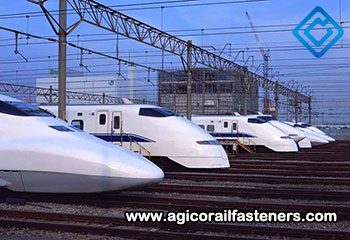Why We Need Under Sleeper Pads For Railroad Track
What are Under Sleeper Pads?
The under sleeper pad is a rubber pad that is laid under the railway sleeper, which is a kind of rail pad.

In order to reduce the vibration and noise generated by wheel-rail contact, the usual method used in railway engineering is to place under sleeper pad under the rails, the sleepers and the ballasts. Rail pads can be divided into under-rail rubber pads, under sleeper pads and under- ballast rubber pads depending on the location of use. Three types of rail pads are sequentially reduced in stiffness. The under-rail rubber pad needs to be laid on all rail lines, and the under sleeper pads and under- ballast rubber pads are laid on different sections according to the shock absorbing requirements.
The under sleeper pads are mainly used in special vibration-damping areas, such as tunnels, bridges and culverts, etc. The lower part of these sections is a rigid foundation, and the stacking height of the ballast is insufficient, resulting in insufficient track elasticity. Laying under sleeper pads under the railway sleeper can effectively solve the problem of insufficient elasticity. The under sleeper pad material under the railway sleeper is mainly composed of EPDM rubber and neoprene, and the part of the bottom in contact with ballast must have good puncture resistance. In addition, good mechanical properties, aging resistance and fatigue properties are all necessary characteristics of under sleeper pads.
Under-rail Rubber Pads
Under-rail rubber pads are the most widely used rail pads on the railway line. Each under-rail rubber pad weighs about 400g and requires about 3,600 under-rail rubber pads per kilometer. According to the railway maintenance standard, the under-rail rubber pad needs to be replaced every 10 years (or based on the passing gross load). With the development of railway construction, the types of under-rail rubber pads are constantly expanding. According to the different structure, the under-rail rubber pad can be divided into groove type rubber pad, nail type rubber pad and flat type rail pad.

The rubber material used for under-rail rubber pads is mainly styrene-butadiene rubber and natural rubber. Special rubber is used in special areas. For example, EPDM rubber is used in the cold region, and neoprene is used in the subway and some railway turnout areas.
Under- ballast Rail Pads
Under-ballast rail pad is laid at the bottom of the ballast, which is mostly used in tunnels and bridge sections to make up for the lack of elasticity caused by the insufficient height of the ballast. In order to be able to be in close contact with the ballast while providing sufficient elasticity, the under-ballast rail pad is often designed as a tapered structure or a truncated conical structure.
With the construction of ballastless track on a large scale, ballastless track has been gradually cancelled and sleeper has become sleeper board. In special areas, if the train passes through densely populated areas, it will set up vibration reduction track. That is, a layer of 10-25mm thick micro-porous mat is laid under the rail slab to reduce vibration and noise propagation to the surrounding area.
As a professional under sleeper pads manufacturer, you are reminded that under sleeper pads and under-rail pads are indispensable parts for laying railways and are essential elements for ensuring railway safety. Choose under sleeper pads, must choose high quality under sleeper pads manufacturers. AGICO Railway is always at your service.
We receive enquiries in English, Español (Spanish), Русский язык (Russian), Français (French) and العربية (Arabic). Our professional team will reply to you within one business day. Please feel free to contact us!



